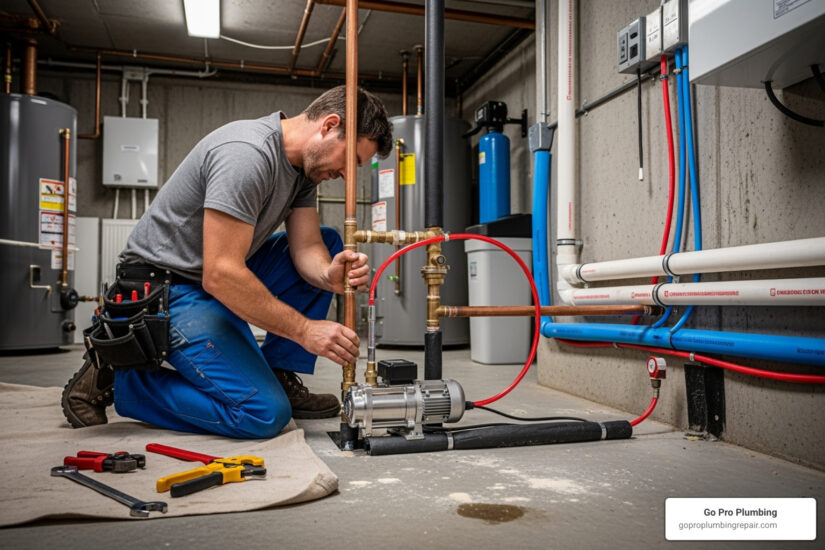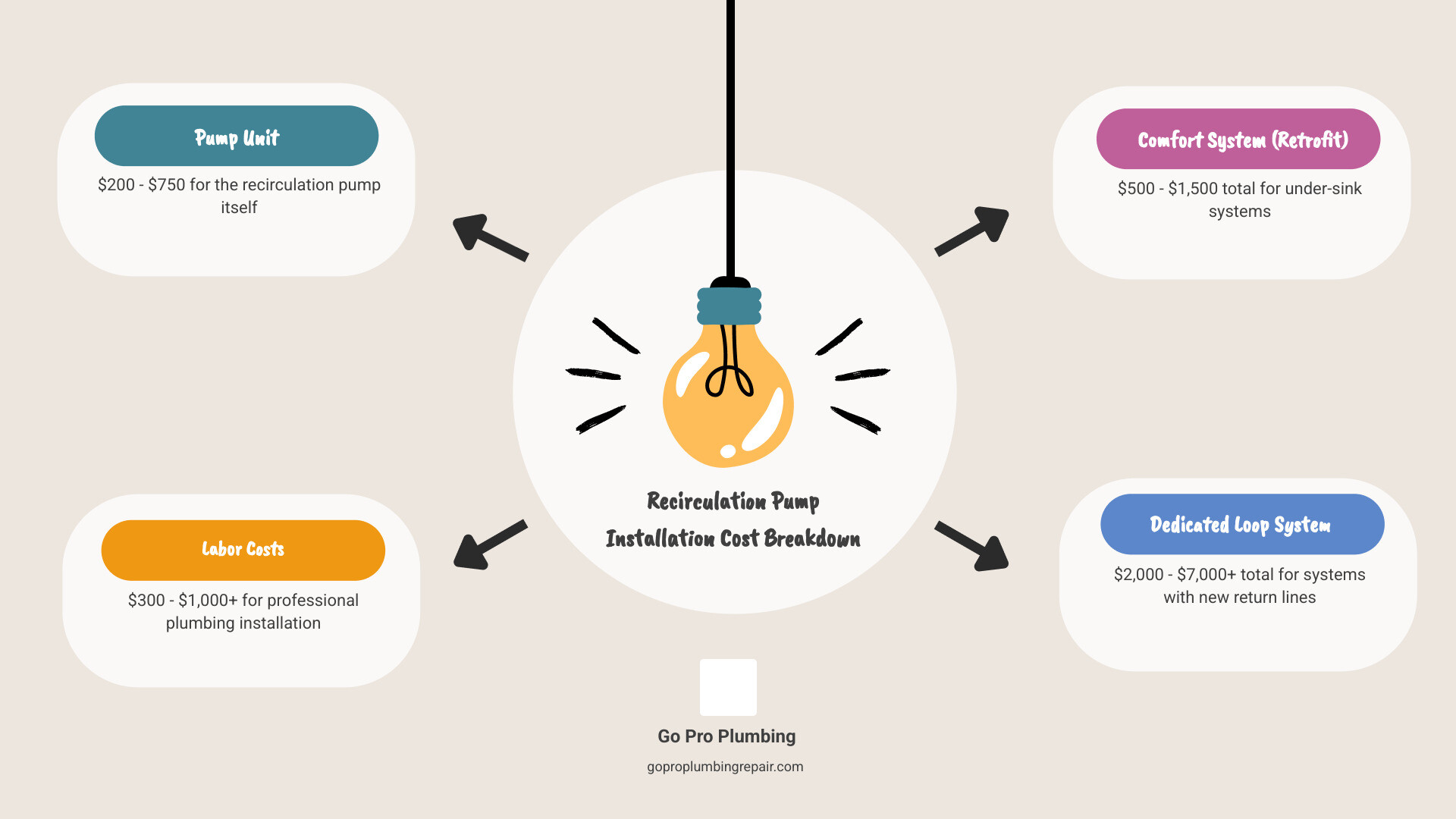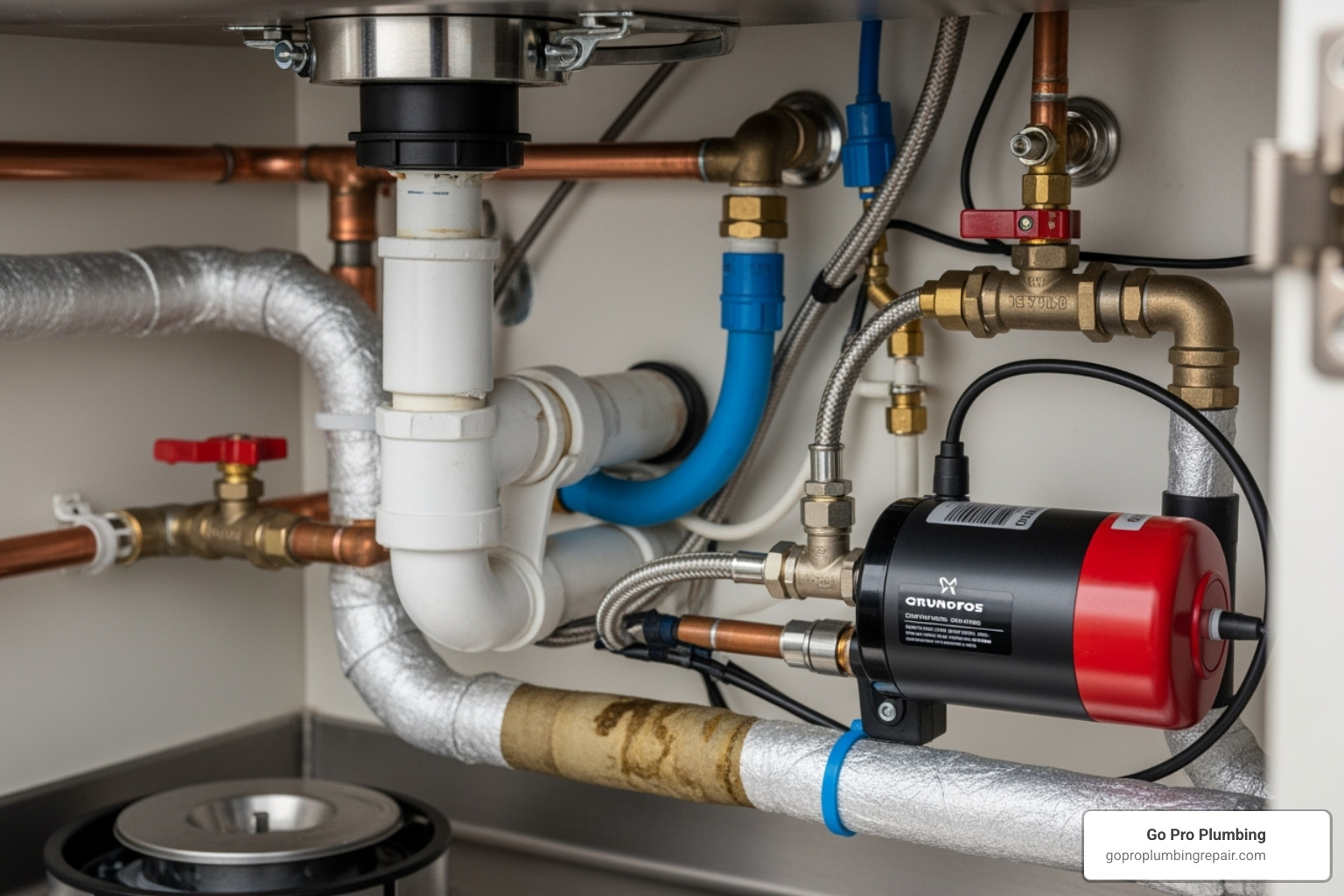Budgeting for Warmth: Your Guide to Recirculation Pump Installation Costs
By Brian on October 15, 2025

Why Understanding Recirculation Pump Installation Cost Matters
The recirculation pump installation cost typically ranges from $500 to $7,000, depending on the system type and complexity. Here’s a quick budget breakdown:
Quick Cost Breakdown:
- Pump unit: $200-$750
- Labor costs: $300-$1,000+
- Comfort system (retrofit): $500-$1,500 total
- Dedicated loop system: $2,000-$7,000+ total
Millions of homeowners face the daily frustration of waiting for hot water, wasting precious time and water. A hot water recirculation pump solves this by creating a continuous loop that keeps hot water ready at your taps. However, like any home improvement, the costs can vary dramatically.
The main factors affecting your total investment include:
- Type of system (comfort vs. dedicated loop)
- Your home’s plumbing layout
- Local labor rates in Northern California
- Additional materials needed
Understanding these costs upfront helps you make the right decision for your home and budget. Whether you’re tired of wasting water or simply want the luxury of instant hot water, knowing what to expect financially is the first step.

Breaking Down the Recirculation Pump Installation Cost
The total recirculation pump installation cost breaks down into three main parts: the pump unit, professional labor, and any additional materials. These systems create a continuous loop to keep hot water moving through your pipes, so it’s always ready when you turn the tap. For more technical details, see how a hot water recirculating system works.
Let’s break down each cost component.
Cost of the Hot Water Recirculation Pump Unit
The pump unit itself typically costs $200 to $750. The price varies based on several factors:
- Material: Quality pumps use corrosion-resistant bronze or stainless steel for longevity.
- Horsepower: The pump must be properly sized for your home. A pump that’s too small is ineffective, while one that’s too large wastes energy. Our technicians calculate the right size for your home’s layout.
- Brand: Established brands may cost more but often offer better warranties and support.
- Features: Modern pumps include features that increase upfront cost but save money over time. Timers let you schedule operation, aquastats (temperature sensors) run the pump only when needed, and smart controls offer Wi-Fi connectivity for remote management. These features often pay for themselves through energy savings and convenience.
Professional Installation and Labor Costs
Professional installation is a key part of the recirculation pump installation cost. While DIY is tempting for simple systems, professional work prevents costly mistakes and is strongly recommended.
Labor costs typically run $300 to $1,000 or more, depending on job complexity. A simple comfort system may take a few hours, while a dedicated loop is a multi-day project. In Northern California, rates reflect the local cost of living and demand for skilled plumbers.
Additional costs depend on your home’s setup. You may need new piping for a dedicated return line, a new electrical outlet near the water heater, or specialized fittings.
We’ve handled simple installations for around $500 (when combined with other work) and complex ones over $1,200. Every home is unique, so we provide a detailed quote after an assessment to ensure transparent pricing.
How System Type Affects Your Total Cost
The type of system you choose is the biggest factor in your total recirculation pump installation cost. The two main options are comfort systems (a budget-friendly retrofit) and dedicated loop systems (a premium, full-house solution). Both solve the problem of waiting for hot water, but their design and cost differ significantly. For a deeper dive into the engineering, see our guide on Hot Water Recirculation System Design.
Comfort Systems (Under-Sink Retrofit)
Comfort systems are a clever, budget-friendly solution that keeps the recirculation pump installation cost reasonable by using your existing plumbing.
They use the cold water line as a return path to the water heater. A pump near the water heater pushes hot water through the lines. At the farthest fixture, a sensor valve opens to let cooled water flow into the cold line. When hot water arrives, the valve closes, and the pump stops.
The total cost for comfort systems is typically $500 to $1,500, including equipment and professional installation.

They are ideal for existing homes, providing instant hot water to specific areas like a kitchen or master bath without the cost and mess of running new pipes.
If you’re leaning toward a comfort system, our Hot Water Recirculation System Installation Guide walks you through what to expect.
Dedicated Loop Systems (Full Recirculation)
Dedicated loop systems are the premium solution, creating a true circulation loop for your entire home.
The key feature is a dedicated return line, a separate pipe running from the farthest fixture back to the water heater. This allows hot water to circulate continuously, ensuring it’s always available at every tap. This method is more efficient as it doesn’t mix with cold water lines.
However, the recirculation pump installation cost is much higher. Installing the dedicated return line is invasive, often requiring opening walls and running new pipes, which can cost $4,200 to $6,900 alone.
The total cost for dedicated loop systems is typically $2,000 to $7,000 or more.
These systems are best for new construction or major remodels and are ideal for larger homes with distant fixtures. While the upfront cost is high, they provide unparalleled convenience and efficiency.
Is a Recirculation Pump a Good Investment? Calculating the ROI
When considering the recirculation pump installation cost, it’s natural to ask, “Is it worth it?” The return on investment (ROI) includes financial savings, but the primary benefit for most is convenience. The efficiency debate is complex; for a deeper look, check out Are Hot Water Recirculating Systems Efficient?.
The Savings: Reduced Water Waste
A major benefit is reduced water waste. The average household wastes about 11,461 gallons of water annually just waiting for it to heat up.
Consider your shower: an average showerhead uses 2.1 gallons per minute. A 90-second wait wastes over three gallons per shower. Multiplied over a year, this adds up to thousands of gallons.
This translates to real savings on your water bill. In water-conscious Northern California, the environmental benefit is also significant. Many customers appreciate the conservation aspect as much as the convenience.
The Ongoing Costs: Electricity and Maintenance
Recirculation pumps use electricity, which affects the ROI.
Most pumps are energy-efficient, using only 25-40 watts. Running continuously, a 25-watt pump costs about $10-$35 annually in electricity. However, modern pumps with timers or aquastats run only when needed, cutting operating costs to as little as $5-$10 per year.
A more significant ongoing cost is heat loss from uninsulated pipes, which makes your water heater work harder. This can add $160 to $400 to your annual energy bill, according to data on Heat Loss from Uninsulated Copper Tubes. Proper pipe insulation is crucial to minimize this cost and improve efficiency.
Maintenance is minimal, involving occasional checks for leaks and proper timer settings. For potential issues, see our guide on Hot Water Recirculation System Problems.
The Payback Period: When is it Worth the Recirculation Pump Installation Cost?
From a purely financial standpoint, the payback period based on water savings versus energy costs can be long.
However, the primary return for most homeowners is convenience. The luxury of instant hot water is often the main reason for installation, making the recirculation pump installation cost feel worthwhile from day one.
The financial payback is faster in specific scenarios:
- Large homes with long pipe runs where water waste is higher.
- Areas with high water costs, like parts of Northern California.
- Households with frequent hot water use, such as large families.
For these homes, the combination of financial savings, convenience, and environmental responsibility provides a strong ROI. If you value time savings and water conservation, a recirculation pump is an excellent investment in your quality of life.
DIY vs. Professional Installation
When considering the recirculation pump installation cost, many wonder whether to DIY or hire a professional. There’s a trade-off between cost savings and risk. While some plumbing seems straightforward, working with water and electricity is best left to experts.
The DIY Option: Cutting Labor Costs
A DIY installation can save on labor costs, especially for comfort kits designed for this purpose. These systems are relatively simple, taking 1-2 hours to install. The potential savings on labor can be $300 to $600 or more, significantly reducing the total recirculation pump installation cost.
However, the risks are substantial. Leaks from bad connections can cause major water damage. Electrical hazards are a serious concern. An improper installation can lead to inefficiency or system failure. Furthermore, a DIY installation may void the manufacturer’s warranty.
Note: Go Pro Plumbing strongly recommends professional installation for safety, optimal performance, and warranty protection. Our licensed plumbers ensure your system operates flawlessly.
Hiring a Professional: Peace of Mind
Hiring a professional provides peace of mind and protects your investment. Our plumbers offer key benefits:
- Correct Sizing: We assess your home’s layout to select the right pump for maximum efficiency.
- Code Compliance: We ensure your installation meets all local Northern California building codes.
- Safety and Warranty: We handle all connections safely, minimizing risks. Professional installation protects your manufacturer’s warranty and includes our labor warranty.
For dedicated loop systems, professional installation is essential. This complex job involves running new pipes and requires expertise to avoid costly structural damage.
While it adds to the initial recirculation pump installation cost, professional installation is an investment in safety, efficiency, and reliability. Go Pro Plumbing provides expert service to ensure your system is installed perfectly.
Frequently Asked Questions about Recirculation Pump Costs
We get plenty of questions from homeowners across Northern California about hot water recirculation pumps. Let’s tackle the most common ones.
How much does it cost to install a recirculation pump for a tankless water heater?
The recirculation pump installation cost for a tankless water heater is similar to a traditional one, ranging from $500 to $7,000+ depending on the system type.
Even with on-demand heating, tankless units still have a delay as water travels through the pipes. A recirculation pump eliminates this wait.
Compatibility is crucial, as not all tankless models work with all pumps. A professional assessment is vital. Some newer tankless heaters have built-in recirculation pumps, which simplifies installation.
As with any installation, a comfort system will cost less than a dedicated loop. For more details, see our guide on Hot Water Recirculation for Tankless System.
How much electricity does a hot water recirculation pump use?
Recirculation pumps are highly energy-efficient.
Most residential pumps use only 25-40 watts. If a 25-watt pump ran continuously, it would use about 200 kWh per year.
However, modern pumps don’t run non-stop. Smart features significantly reduce energy use:
- Timers allow you to schedule operation during peak hours, cutting annual usage to 40-80 kWh.
- Aquastats (temperature sensors) run the pump only when water temperature drops, reducing annual electricity costs to as little as $5.50 to $10.
This low electricity cost is often offset by energy savings from your water heater.
Can I get instant hot water without a pump?
While a pump-driven system is the most reliable method for instant hot water, there are related strategies.
- Pipe insulation is a cost-effective first step. It doesn’t provide instant hot water but reduces wait times by keeping water in the pipes hotter for longer.
- Comfort systems are a type of recirculation system that provides near-instant hot water to a specific fixture (like a sink) without requiring new plumbing throughout the house.
For a deeper look at alternatives, see our article on Hot Water Recirculation Without a Pump. However, for consistent, whole-house instant hot water, a pump-driven system is the best solution.
Conclusion
The recirculation pump installation cost ranges from $500 to over $7,000, with the system type being the biggest factor. While these systems provide real water savings, their true value often lies in the convenience of instant hot water.
The environmental benefit is also significant, saving an average household over 11,000 gallons of water annually. This makes it a responsible choice, especially in Northern California.
Go Pro Plumbing has helped homeowners throughout Northern California, from Rancho Cordova to Sacramento, enjoy the daily convenience of instant hot water. Our experienced technicians can assess your home, recommend the right system for your budget, and provide a seamless installation. We are committed to the outstanding customer service and same-day service our clients expect.
For a professional assessment and a precise quote on your water recirculation pump installation, contact us today. Let’s bring the comfort of instant hot water to your home.

